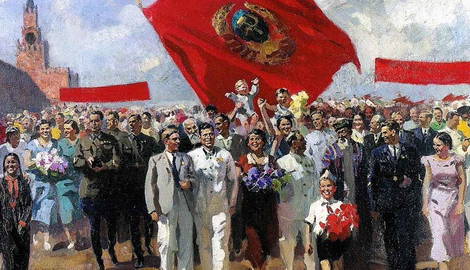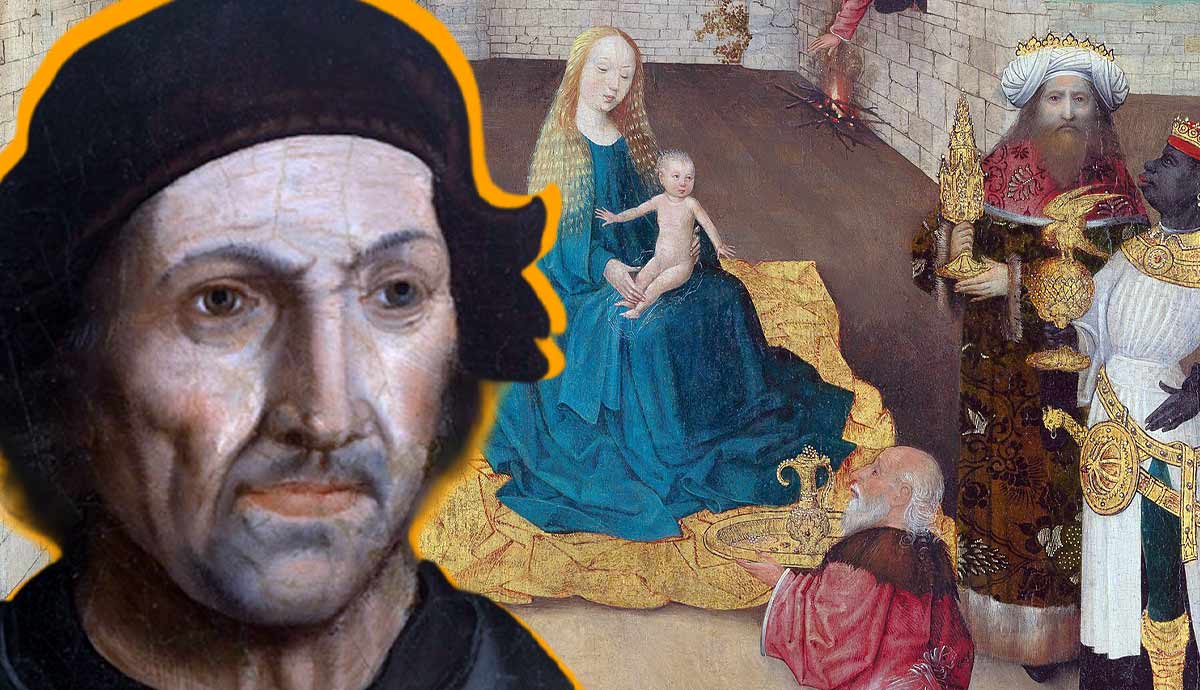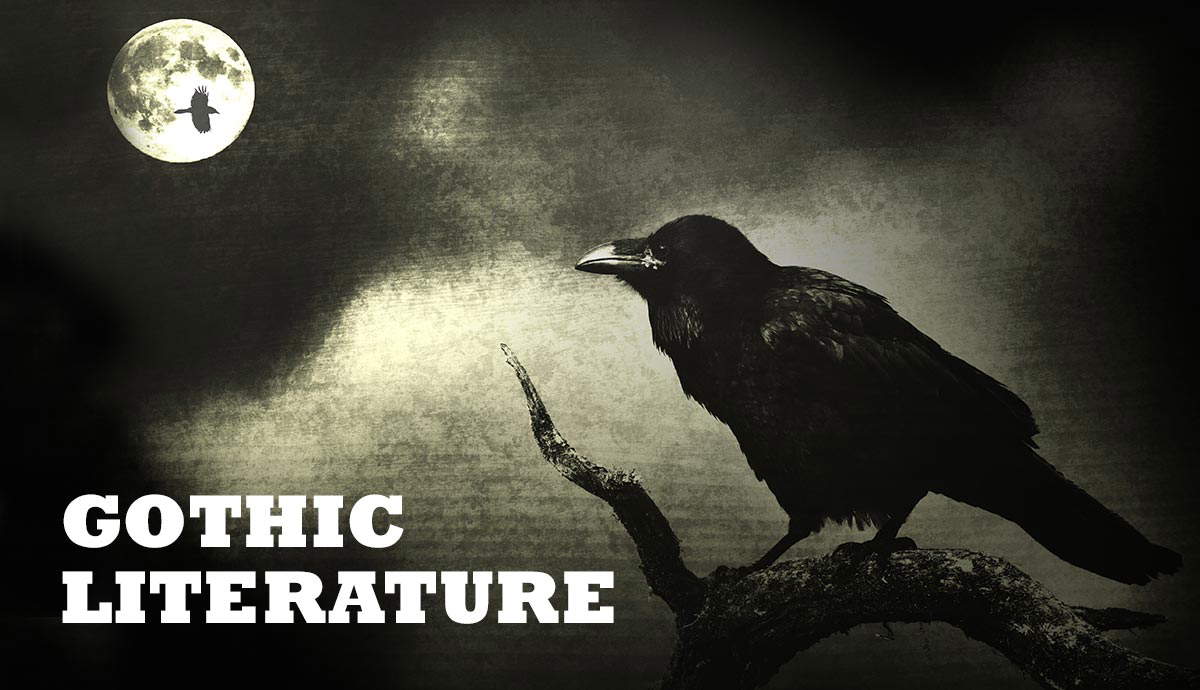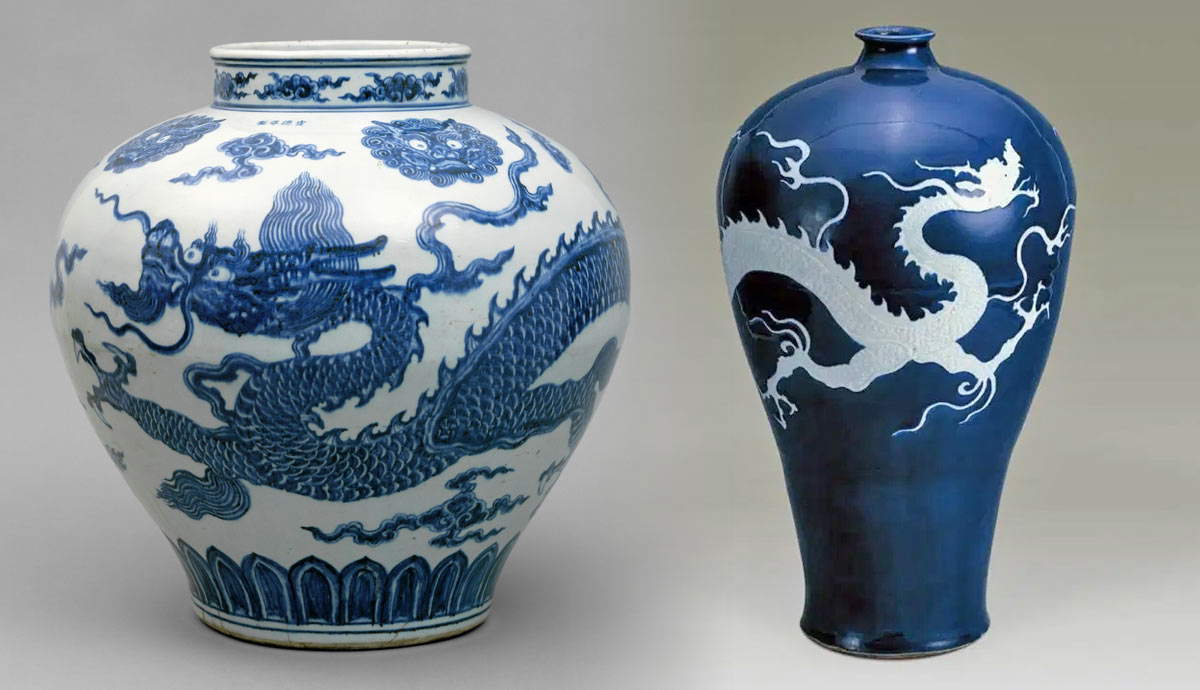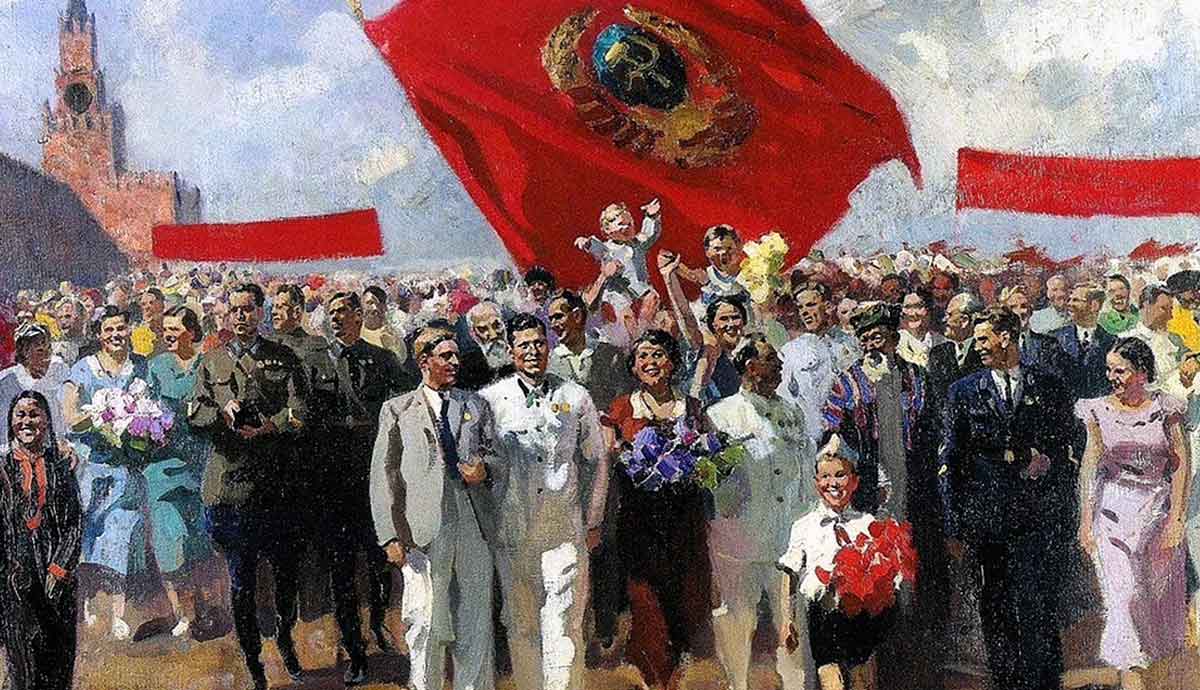
Socialist Realism was the official artistic ideology proclaimed in the 1930s in the Soviet Union. It rejected experimentations with non-objective painting and criticized intellectual art that was not understood by the masses. Socialist realism was supposed to celebrate honest labor and equality at work, as well as glorify Soviet leaders. Apart from its propagandistic function, it also acted as a didactic material that installed moral values. Read on to get familiar with seven major topics persistent in the art of Socialist Realism.
1. Paternalism in Socialist Realism

Soviet culture was essentially paternalist, relying on strict hierarchy and subordination. Joseph Stalin, the country and the party’s leader, was presented as the father to all. Similar images, although to a lesser degree of devotion, applied to figures of high-ranking officials such as military commanders, bosses, or those in charge of production. A leader of any rank was responsible for their subordinate group in terms of both moral and practical matters.
The most obvious expression of this concept could be found in paintings of Soviet leaders meeting soldiers or workers in the atmosphere of a great honor and grandiose blessing. Joseph Stalin and Vladimir Lenin were painted as almost supernatural beings, who suddenly turned their condescending attention to the mortals. Less intense and intimidating versions of that scene could be found in paintings that represented collective celebrations like Labor Day parades or New Year’s Eve, where families, work collectives, and other groups were united around a patriarch.
2. Initiation Rituals

Socialist Realist paintings did not allow for any interpretations apart from those provided by the dominant ideology. All meanings had to be simple and straightforward and were intentionally crafted by artists and censors. In that sense, Socialist Realism relied on narratives that told clear and unambiguous stories. Any experiment with expressive language was discouraged, as the message of the painting had to be clear even to those who never encountered art before. As an artistic ideology, Socialist Realism applied not only to art but also to literature and film. Socialist Realism was based on three principles: it had to be relatable to common people, illustrate their quest for a better future, and contribute to transforming a regular person’s mindset.
One of the most popular topics of Socialist Realist art, direct and full of ceremonial grandeur, was the initiation ritual that signified a change of social status. In Soviet contexts, such rituals included not only weddings, military oaths, or education milestones but also one’s enlistment into youth organizations and workers’ unions. Many Socialist Realist paintings included children learning how to correctly wear the red tie that signified their belonging to the Young Pioneers organization—the Soviet alternative to the Scout movement.
3. Conflict of the Old and the New Worlds

Although many Socialist Realist paintings were cheerful and optimistic, the undertone of conflict was nonetheless present. The joyful utopia needed an enemy that was both significant enough to cause a threat and weak enough to avoid causing any serious damage before the dutiful Soviet citizens would interfere. Socialist Realist works often featured trials over foreign spies or saboteurs or even informal conversations with idle workers or school students who failed to pass a test. Regardless of how grave the crime was, the message of social condemnation and the clear distinction between good and evil was clear. Art historians noted that such paintings had an almost religious undertone, similar to that of Christian moralist art.
Another popular topic was the conflict between the new Soviet citizens and the remnants of the pre-Soviet past, like factory owners, businessmen, and monarchists. These people, who were often the unfair victims of the Revolution, became the embodiment of oppression and greed that was supposedly defeated by the new regime.
4. Group Portraits and Monumental Still-Lifes

Heavyweight group portraits were one of the most recognizable features of the Socialist Realism. These portraits often represented not particular personalities but a collective idealized representation of Soviet citizens—physically fit, happy, and morally perfect. In most cases, these groups lacked individual personalities, representing a coherent mass of people who look and think alike and are unanimously content with their shared lifestyle. One-figure portraits were also popular, although they usually focused on a single outstanding figure in their field—a surgeon, a sculptor—or an archetypal image of a perfect worker or ideal farmer.

Artists also frequently painted group portraits of political figures and party elites, but these images were rather risky, particularly in specific eras of Soviet history. During Stalin’s Great Purge in the 1930s, many members of the ruling class were imprisoned or executed, and their images had to be removed from group paintings and individual portraits. Artists often had to completely redo their compositions to avoid misunderstanding and repressions.
The most popular format for a Socialist Realist painting was horizontal, as it offered stability and weight that impressed the viewers and gave a sense of grandeur and security. Still-lifes and scenes of crop harvesting had to be overwhelmingly abundant, even if that was rarely the case in real life.
5. Factory Labor

One of the most impressive aspects of the early decades of Socialist Realism was the emotionally intense depiction of factory labor and construction sites. The genre itself was far from new and was explored by many modern artists. Images of heavy machinery were similarly employed by Futurists and their colleagues. Through the Socialist Realist lens, however, the focus shifted to the way humans mastered these machines. In their resilience and dedication to the cause, they became even more powerful than mechanisms.
Apart from labor, this subgenre often celebrated the athletic human body, showing average workers looking like ancient gods. In terms of gender equality, early Soviet art was surprisingly diverse, emphasizing effective and joyful labor in any industry with little to no limitations. Both in reality and painting, men and women worked together with equal pay and conditions. Standards of beauty were also radically different, usually emphasizing strong athletic bodies fit for physical work.
6. Life and Death During World War II

A particular segment of Socialist Realist historical art related to almost immediate history was devoted to the Great Patriotic War or the Eastern Front of World War II. In June 1941, Nazi Germany invaded the Soviet Union. Over the four years of war, the Soviets lost more than 26 million soldiers and civilians. Already during the war, Socialist Realism artists started to work on paintings that reflected upon the sacrifices of soldiers and workers, as well as the meaningless atrocities committed during the war. Once again, this art reinforced its propagandistic function, acting as a reinforcement tool for those supplying the frontlines with ammunition. Other popular subgenres were family reunions and letters arriving from the frontlines. During and after the war, Socialist Realism toned down the grandiose tones of utopian futures and ideal citizens and turned towards real humans with their sentimental feelings and hopes.
7. Future in the Present: The Utopia of Socialist Realism

As stated by the Soviet authorities, the bright future of victorious communism was already underway. Thus, it had to be inextricably linked to the present and look like an idealized version of the current reality. For that reason, images of the future almost never featured high-tech skyscrapers or innovative urbanistic decisions. They demonstrated Soviet reality, enhanced and glossed over with promises of material abundance, happy families, personal transport, and comfort. Critics of Socialist Realism noted that the promised future already happened for the selected few who represented the country’s governmental bodies.
The painting New Moscow, created in 1937, at the peak of Stalin’s purges of the elites who were not loyal enough, was supposed to represent an average Moscow woman driving her car through the city center. Contemporaries, however, recognized her as the wife of some party boss, as only the ruling class at the time was allowed to have personal transport. Thus, despite the claims of equality and fair pay, social hierarchy was deeply ingrained into Soviet reality.
However, after the war was over and Joseph Stalin died in 1953, the movement gradually began to lose its emotional effect on the viewer. The dissonance between painted images and post-war reality became all too apparent and lost its appeal. By the 1960s, the underground culture of modernist and conceptual art started to gain momentum despite all restrictions and offered an alternative to the uniformity of Socialist Realism.
